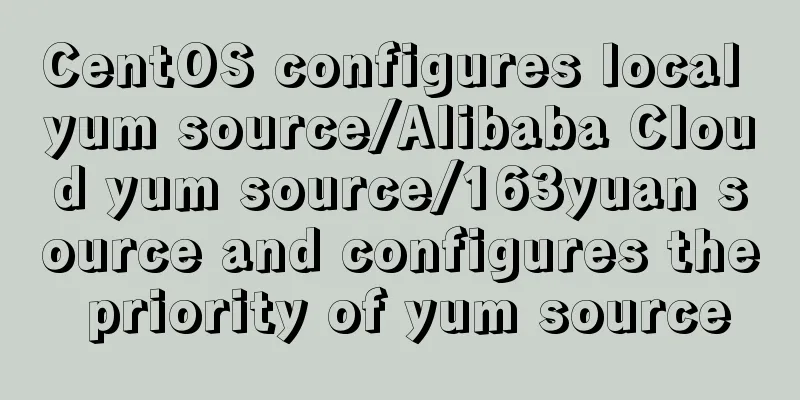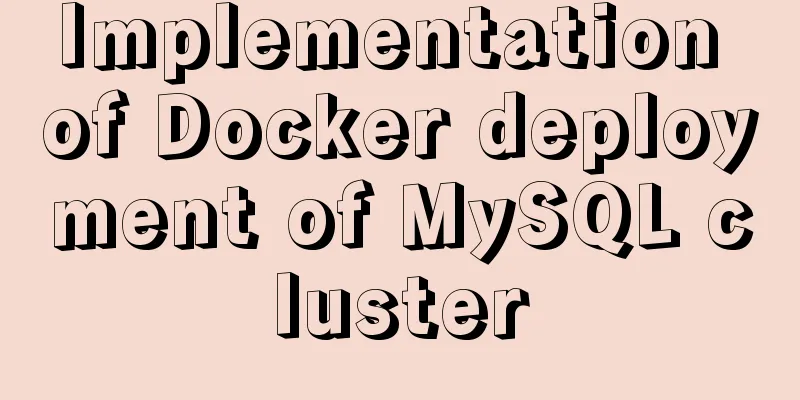CentOS configures local yum source/Alibaba Cloud yum source/163yuan source and configures the priority of yum source

|
1. Use Centos image to build local yum source Since the default yum source after installing centos is the official address of centos, it is very slow to use or even inaccessible in China. Therefore, the general practice is to replace the default yum source with aliyun's yum source or 163 and other domestic yum sources (the following describes how to configure it). However, the above methods all require the Internet, and they cannot be used when there is no Internet. Therefore, another commonly used method is to use the Centos iso image to build a local yum source, which will greatly speed up the installation of the software. The disadvantage is that some packages may not be available. 1. The default yum source after installing Centos is as follows [root@kangvcar ~]# ll /etc/yum.repos.d/ total 32 -rw-r--r--. 1 root root 1664 Dec 9 2015 CentOS-Base.repo -rw-r--r--. 1 root root 1309 Dec 9 2015 CentOS-CR.repo -rw-r--r--. 1 root root 649 Dec 9 2015 CentOS-Debuginfo.repo -rw-r--r--. 1 root root 290 Dec 9 2015 CentOS-fasttrack.repo -rw-r--r--. 1 root root 630 Dec 9 2015 CentOS-Media.repo -rw-r--r--. 1 root root 1331 Dec 9 2015 CentOS-Sources.repo -rw-r--r--. 1 root root 1952 Dec 9 2015 CentOS-Vault.repo 2. Back up the default yum source (optional) [root@kangvcar ~]# mkdir /opt/centos-yum.bak [root@kangvcar ~]# mv /etc/yum.repos.d/* /opt/centos-yum.bak/ 3. Mount the CentOS image file on the virtual machine
[root@kangvcar ~]# mount -t iso9660 /dev/sr0 /opt/centos mount: /dev/sr0 is write-protected, mounting read-only 4. Write the repo file and point to the mount directory of the image [root@kangvcar ~]# vi /etc/yum.repos.d/local.repo [local] name=local baseurl=file:///opt/centos enabled=1 gpgcheck=0 5. Clear cache [root@kangvcar ~]# yum clean all Loaded plugins: fastestmirror Cleaning repos: local Cleaning up everything Cleaning up list of fastest mirrors [root@kangvcar ~]# yum makecache //Cache the yum source locally to speed up software search and installation [root@kangvcar ~]# yum list //Lists 3780 packages 2. Change the default CentOS yum source to the domestic aliyun yum source Alibaba Cloud official tutorial: http://mirrors.aliyun.com/help/centos 1. The default yum source after installing Centos is as follows [root@kangvcar ~]# ll /etc/yum.repos.d/ total 32 -rw-r--r--. 1 root root 1664 Dec 9 2015 CentOS-Base.repo -rw-r--r--. 1 root root 1309 Dec 9 2015 CentOS-CR.repo -rw-r--r--. 1 root root 649 Dec 9 2015 CentOS-Debuginfo.repo -rw-r--r--. 1 root root 290 Dec 9 2015 CentOS-fasttrack.repo -rw-r--r--. 1 root root 630 Dec 9 2015 CentOS-Media.repo -rw-r--r--. 1 root root 1331 Dec 9 2015 CentOS-Sources.repo -rw-r--r--. 1 root root 1952 Dec 9 2015 CentOS-Vault.repo 2. Back up the default yum source (optional) [root@kangvcar ~]# mkdir /opt/centos-yum.bak [root@kangvcar ~]# mv /etc/yum.repos.d/* /opt/centos-yum.bak/ 3. Download the aliyun yum source repo file (download the corresponding system version) #Download operations corresponding to the repo files of each system version CentOS 5 wget -O /etc/yum.repos.d/CentOS-Base.repo http://mirrors.aliyun.com/repo/Centos-5.repo CentOS 6 wget -O /etc/yum.repos.d/CentOS-Base.repo http://mirrors.aliyun.com/repo/Centos-6.repo CentOS 7 wget -O /etc/yum.repos.d/CentOS-Base.repo http://mirrors.aliyun.com/repo/Centos-7.repo [root@kangvcar ~]# cat /etc/redhat-release //View the system version CentOS Linux release 7.2.1511 (Core) [root@kangvcar ~]# wget -O /etc/yum.repos.d/CentOS-Base.repo http://mirrors.aliyun.com/repo/Centos-7.repo --2017-06-20 06:43:08-- http://mirrors.aliyun.com/repo/Centos-7.repo Resolving mirrors.aliyun.com (mirrors.aliyun.com)... 112.124.140.210, 115.28.122.210 Connecting to mirrors.aliyun.com (mirrors.aliyun.com)|112.124.140.210|:80... connected. HTTP request sent, awaiting response... 200 OK Length: 2573 (2.5K) [application/octet-stream] Saving to: '/etc/yum.repos.d/CentOS-Base.repo' 100%[===================================================================================================================>] 2,573 --.-K/s in 0s 2017-06-20 06:43:08 (118 MB/s) - '/etc/yum.repos.d/CentOS-Base.repo' saved [2573/2573] 4. Clear the cache [root@kangvcar ~]# yum clean all Loaded plugins: fastestmirror Cleaning repos: base extras updates Cleaning up everything Cleaning up list of fastest mirrors [root@kangvcar ~]# yum makecache //Cache the yum source locally to speed up software search and installation [root@kangvcar ~]# yum list //A total of 9954 packages are listed 3. Change the default CentOS yum source to the domestic 163 source 163 official tutorial: http://mirrors.163.com/.help/centos.html 1. The default yum source after installing Centos is as follows [root@kangvcar ~]# ll /etc/yum.repos.d/ total 32 -rw-r--r--. 1 root root 1664 Dec 9 2015 CentOS-Base.repo -rw-r--r--. 1 root root 1309 Dec 9 2015 CentOS-CR.repo -rw-r--r--. 1 root root 649 Dec 9 2015 CentOS-Debuginfo.repo -rw-r--r--. 1 root root 290 Dec 9 2015 CentOS-fasttrack.repo -rw-r--r--. 1 root root 630 Dec 9 2015 CentOS-Media.repo -rw-r--r--. 1 root root 1331 Dec 9 2015 CentOS-Sources.repo -rw-r--r--. 1 root root 1952 Dec 9 2015 CentOS-Vault.repo 2. Back up the default yum source (optional) [root@kangvcar ~]# mkdir /opt/centos-yum.bak [root@kangvcar ~]# mv /etc/yum.repos.d/* /opt/centos-yum.bak/ 3. Download the 163 yum source repo file #Download operations corresponding to the repo files of each system version CentOS 5 wget -O /etc/yum.repos.d/CentOS5-Base-163.repo http://mirrors.163.com/.help/CentOS5-Base-163.repo CentOS 6 wget -O /etc/yum.repos.d/CentOS6-Base-163.repo http://mirrors.163.com/.help/CentOS6-Base-163.repo CentOS 7 wget -O /etc/yum.repos.d/CentOS7-Base-163.repo http://mirrors.163.com/.help/CentOS7-Base-163.repo [root@kangvcar ~]# cat /etc/redhat-release //View the system version CentOS Linux release 7.2.1511 (Core) [root@kangvcar ~]# wget -O /etc/yum.repos.d/CentOS7-Base-163.repo http://mirrors.163.com/.help/CentOS7-Base-163.repo --2017-06-20 06:29:47-- http://mirrors.163.com/.help/CentOS7-Base-163.repo Resolving mirrors.163.com (mirrors.163.com)... 123.58.173.185, 123.58.173.186 Connecting to mirrors.163.com (mirrors.163.com)|123.58.173.185|:80... connected. HTTP request sent, awaiting response... 200 OK Length: 1572 (1.5K) [application/octet-stream] Saving to: '/etc/yum.repos.d/CentOS7-Base-163.repo' 100%[==================================================================================================================>] 1,572 --.-K/s in 0s 2017-06-20 06:29:47 (293 MB/s) - '/etc/yum.repos.d/CentOS7-Base-163.repo' saved [1572/1572] 4. Clear the cache [root@kangvcar ~]# yum clean all Loaded plugins: fastestmirror Cleaning repos: base extras updates Cleaning up everything Cleaning up list of fastest mirrors [root@kangvcar ~]# yum makecache //Cache the yum source locally to speed up software search and installation [root@kangvcar ~]# yum list //A total of 9951 packages are listed 4. Modify the priority of the yum source ps: When there are both local yum sources and 163 sources, we certainly hope to use the local yum source to install the software package first, and then use the 163 source to install the software when no available package is found locally. This involves the issue of priority. The yum plug-in yum-plugin-priorities.noarch can solve this problem. 1. Check whether the system has installed the priority plug-in [root@kangvcar ~]# rpm -qa | grep yum-plugin- yum-plugin-fastestmirror-1.1.31-34.el7.noarch //Here we can see that the yum-plugin-priorities.noarch plugin is not installed [root@kangvcar ~]# yum search yum-plugin-priorities //Use search to see if this plugin is available Loaded plugins: fastestmirror Loading mirror speeds from cached hostfile * base: mirrors.aliyun.com * extras: mirrors.aliyun.com * updates: mirrors.aliyun.com ============================================================ N/S matched: yum-plugin-priorities =========================================================== yum-plugin-priorities.noarch : plugin to give priorities to packages from different repos 2. Install the yum-plugin-priorities.noarch plugin [root@kangvcar ~]# yum -y install yum-plugin-priorities.noarch 3. Check whether the plug-in is enabled [root@kangvcar ~]# cat /etc/yum/pluginconf.d/priorities.conf [main] enabled = 1 //1 is enabled; 0 is disabled 4. Modify the local yum source to use first [root@kangvcar ~]# ll /etc/yum.repos.d/ total 8 -rw-r--r--. 1 root root 2573 May 15 2015 CentOS-Base.repo -rw-r--r--. 1 root root 67 Jun 20 06:04 local.repo //There are two repo files [root@kangvcar ~]# vi /etc/yum.repos.d/local.repo [local] name=local baseurl=file:///opt/centos enabled=1 gpgcheck=0 priority=1 //Add priority=1 to the original value; the smaller the number, the higher the priority. //You can continue to modify the priority values of other sources. After testing, only configuring the priority of the local source as priority=1 will give priority to the local source. 5. Testing Before configuring the priority: (Using Alibaba Cloud yum source) [root@kangvcar ~]# yum -y install vim Dependencies Resolved ================================================================================================================================================= Package Arch Version Repository Size ================================================================================================================================================= Installing: vim-enhanced x86_64 2:7.4.160-1.el7_3.1 updates 1.0 M Updating for dependencies: vim-common x86_64 2:7.4.160-1.el7_3.1 updates 5.9 M Omit... After configuring the priority: (using local yum source) [root@kangvcar ~]# yum -y install vim Dependencies Resolved ================================================================================================================================================= Package Arch Version Repository Size ================================================================================================================================================= Installing: vim-enhanced x86_64 2:7.4.160-1.el7 local 1.0 M Installing for dependencies: gpm-libs x86_64 1.20.7-5.el7 local 32k perl x86_64 4:5.16.3-286.el7 local 8.0 M perl-Carp noarch 1.26-244.el7 local 19k perl-Encode x86_64 2.51-7.el7 local 1.5 M perl-Exporter noarch 5.68-3.el7 local 28k perl-File-Path noarch 2.09-2.el7 local 26 k perl-File-Temp noarch 0.23.01-3.el7 local 56 k Omit... The above is the full content of this article. I hope it will be helpful for everyone’s study. I also hope that everyone will support 123WORDPRESS.COM. You may also be interested in:
|
>>: How to build a Vue3 desktop application
Recommend
Html sample code for reading and displaying pictures in a local folder
One purpose Select a local folder on the Html pag...
Personalized and creative website design examples (30)
Therefore, we made a selection of 30 combinations ...
Introduction to HTML DOM_PowerNode Java Academy
What is DOM? With JavaScript, you can reconstruct...
Analysis of the reasons why MySQL field definitions should not use null
Why is NULL so often used? (1) Java's null Nu...
MySQL master-slave principle and configuration details
MySQL master-slave configuration and principle, f...
Exploring the practical value of the CSS property *-gradient
Let me first introduce an interesting property - ...
Analysis and solution of Chinese garbled characters in HTML hyperlinks
A hyperlink URL in Vm needs to be concatenated wit...
MySQL 5.7.17 winx64 installation and configuration graphic tutorial
I summarized the previous notes on installing MyS...
mysql settings to change the root password, mysql server connection, mysql common commands diagram
1. Set and change the root password Check whether...
How to query and update the same table in MySQL database at the same time
In ordinary projects, I often encounter this prob...
How to solve the problem of character set when logging in to Linux
Character set error always exists locale: Cannot ...
How to connect a Linux virtual machine to WiFi
In life, the Internet is everywhere. We can play ...
Memcached method for building cache server
Preface Many web applications store data in a rel...
The difference between VOLUME and docker -v in Dockerfile
There are obvious differences between volume moun...
A brief discussion on the perfect adaptation solution for Vue mobile terminal
Preface: Based on a recent medical mobile project...










